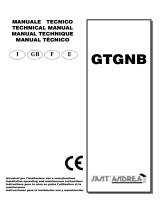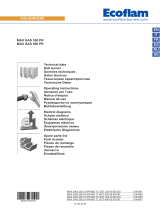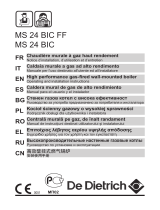Page is loading ...

Remove the “Testing Certificate” from inside the combustion chamber and
keep together with the instructions manual
CONTENTS
1 BOILER DESCRIPTION
1.1 INTRODUCTION . . . . . . . . . . . . . . . . . . . . . . . . . . . . . . . . . . . . . . . . . . . . . . . . . . . . . . . . . . . . . . . . . . . . . . . . . . . . . . . . . . . . . . . 6
1.2 DIMENSIONS
1.3 TECHNICAL FEATURES
1.4 COMBUSTION CHAMBER DIMENSIONS
2 INSTALLATION
2.1 BOILER ROOM . . . . . . . . . . . . . . . . . . . . . . . . . . . . . . . . . . . . . . . . . . . . . . . . . . . . . . . . . . . . . . . . . . . . . . . . . . . . . . . . . . . . . . . . 7
2.2 BOILER ROOM DIMENSIONS
2.3 CONNECTING UP SYSTEM
2.4 CONNECTING UP FLUE
2.5 FITTING THE CASING
2.6 ELECTRICAL CONNECTION . . . . . . . . . . . . . . . . . . . . . . . . . . . . . . . . . . . . . . . . . . . . . . . . . . . . . . . . . . . . . . . . . . . . . . . . . . . . . 8
3 USE AND MAINTENANCE
3.1 COMMISSIONING THE BOILER . . . . . . . . . . . . . . . . . . . . . . . . . . . . . . . . . . . . . . . . . . . . . . . . . . . . . . . . . . . . . . . . . . . . . . . . . . 9
3.2 LIGHTING THE BOILER
3.3 CLEANING THE BOILER
ENGLISH

6
1.1 INTRODUCTION
The new “AR” series of cast iron boilers
has been designed in compliance with all
applicable safety standards. They use
light oil and have a perfectly balanced
combustion with a very high thermal
efficiency for economical performance.
The components for “AR” installation
are supplied in two separate packages:
boiler body, casing with enclosed docu-
ments and control panel.
1 BOILER DESCRIPTION
1.2 DIMENSIONS
Fig. 1
AR3 AR4 AR5
Output kW 18.9 29.4 40.0
kcal/h 16,300 25,300 34,400
Input kW 21.5 33.4 45.4
kcal/h 18,500 28,700 39,000
P Depth mm 395 495 595
Number of sections 345
Maximum water head bar 4 4 4
Water content l192327
Smoke ∆p mbar 0.10 0.12 0.16
Water ∆p (∆t 10°C) mbar 1.80 2.50 3.50
Combustion capacity kg/h 2.04 2.93 3.97
Injector flow rate gall/h 0.50 0.65 1.00
Atomising angle 80°R 60° 60°
Atomising pressure kg/cm
2
8.5 12.0 9.7
Weight kg 92 122 147
1.3 TECHNICAL FEATURES
M C.H. flow 1
1
/
2
”
R C.H. return 1
1
/
2
”
S Boiler filling drain 1/2”
Fig. 2
AR3 AR4 AR5
L mm 277 377 477
Volumen m
3
0.013109 0.019028 0.024947
1.4 COMBUSTION CHAMBER DIMENSIONS

2.1 BOILER ROOM
The boiler room should feature all the
characteristics required by standards
governing liquid fuel heating systems.
2.2 BOILER ROOM DIMENSIONS
Position the boiler body on the founda-
tion bed, which should be at least 10
cm high. The body should rest on a
surface allowing shifting, possibly by
means of sheet metal.
Leave a clearance between the boiler
and the wall of at least 0.60 m, and
between the top of the casing and the
ceiling of 1 m (0.50 m in the case of
boilers with incorporated D.H.W. tank).
The ceiling height of the boiler room
should be less than 2.5 m.
2.3 CONNECTING UP SYSTEM
When connecting up the water supply
to the boiler, make sure that the speci-
fications given in fig. 1 are observed.
Make connections with rigid unions or
flexible steel hoses that do not place
the unit under strain. All connecting
unions should be easy to disconnect by
means of tightening rings.
2.3.1 Filling the water system
Before connecting the boiler, thorou-
ghly flush the system to eliminate
scale which could damage the
appliance.
Filling must be done slowly so as to
allow any air bubbles to be bled off
through the air valves.
In closed-circuit heating systems, the
cold water filling pressure and the pre-
charging pressure of the expansion
vessel should be no less than or equal
to the height of the water head of the
installation (e.g. for water head of 5
metres, the vessel pre-charging pres-
sure and installation filling pressure
should be at least 0.5 bar).
2.3.2 Water system
characteristics
THE WATER USED FOR THE CENTRAL
HEATING SYSTEM SHOULD BE TREA-
TED IN THE FOLLOWING CASES:
– For extensive systems (with high
contents of water).
– Frequent addition of water into the
system.
– Should it be necessary to empty the
system either partially or totally.
2.4 CONNECTING UP FLUE
The flue is of fundamental importance
for the proper operation of the boiler;
if not installed in compliance with the
standards, starting the boiler will be
difficult and there will be a consequent
formation of soot, condensate and
encrustation.
The flue used to expel combustion pro-
ducts into the atmosphere must meet
the following requirements:
– be constructed with waterproof
materials, and resistant to smoke
temperature and condensate;
– be of adequate mechanical resilien-
ce and of low heat conductivity;
– be perfectly sealed to prevent coo-
ling of the flue itself;
– be as vertical as possible; the termi-
nal section of the flue must be fitted
with a static exhaust device that
ensures constant and efficient
extraction of products generated by
combustion;
– to prevent the wind from creating
pressure zones around the chimney
top greater than the uplift force of
combustion gases, the exhaust
outlet should be at least 0.4 m
higher than structures adjacent to
the stack (including the roof top)
within 8 m;
– have a diameter that is not inferior
to that of the boiler union: square or
rectangular-section flues should
have an internal section 10% grea-
ter than that of the boiler union;
– the useful section of the flue must
conform to the following formula:
S resulting section in cm
2
K reduction coefficient for liquid
fuels:
– 0.045 for firewood
– 0.030 for coal
– 0.024 for light oil
– 0.016 for gas
P boiler input in kcal/h
H height of flue in metres, measu-
red from the flame axis to the
top of the flue reduced by:
– 0.50 m for each change of
direction of the connection
union between boiler and flue;
– 1.00 m for each metre of
union itself.
2.5 FITTING THE CASING
The casing and the control panel are
supplied in separate cardboard packa-
ge. The housing package also contains
the boiler documents and the glass
wool for insulating the cast iron body. To
fit the casing, proceed as follows (fig. 3):
– Remove the four screws, then the
burner plate.
– Position the glass wool (2), secure
the front panel (3) with the nuts sup-
7
2 INSTALLATION
P
S=K
√H
Fig. 3

plied, then refit the burner plate.
– Place de glass fibre (1) around the
boiler body.
–
Mount the left (4) and right (5) sides
introducing the slot of the rear fold
between the two nuts on the tie-rods.
– Secure the sides to the front panel
(3) by means of the pins.
– Secure the two rear panels (6) and
(7) to the sides with the ten tapping
screws supplied.
– Secure the front panel (8) to the
sides by means of the pins.
– Mount the control panel (9) by
means of the pins.
Prior to performing the above ope-
ration, unwind the capillary tubes of
the two thermostats and of the
thermometer by inserting the
respective probes in the holder (11),
then lock with the spring supplied.
It is recommended to complete all
electrical connections as shown in
the paragraph 2.6.
– Complete assembly by securing the
cover (10) to the sides.
NOTE: Remove the “Testing Certifica-
te” from inside the combustion
chamber and keep together with the
instructions manual.
2.6 ELECTRICAL CONNECTION
The boiler is fitted with an electricity
cable, and requires a a single-phase
power supply of 230V - 50Hz through
the main switch protected by fuses.
The room thermostat (required for
enhanced room temperature control)
should be installed as shown in fig. 4.
Connect the burner power cables
supplied.
NOTE: SIME declines all responsibi-
lity for injury caused to persons due
to failure to earth the boiler.
8
KEY
TS H.L. stat
TA Room stat (*)
TC Boiler stat
IG Main switch
PI C.H. pump (*)
B Burner (*)
SB Burner lock-out lamp
(*) Not supplied
Fig. 4

3.1 COMMISSIONING
THE BOILER
When commissioning the boiler
always make sure that:
– No flammable liquids or materials
are near the boiler.
– The electrical connections to the
mains and the earthing are correct.
– The flue and chimney are free from
obstructions.
– The flow and return valves are fully
open.
– The system has been filled with
water and adequately vented.
3.2 LIGHTING THE BOILER
To light the boiler proceed as follows
(fig. 5):
– Check that the “Testing Certificate”
has been removed from inside the
combustion chamber.
– Switch on the main switch (1); the
burner will start immediately or
after a few minutes if there is a pre-
heater.
– Turn the operation thermostat knob
(3) to the desired setting.
3.3 CLEANING THE BOILER
The boiler body and flue should be
cleaned at the end of each season.
The baffles (2 fig. 6) must be removed
before cleaning operations.
Once maintenance has been comple-
ted, reposition the baffles. Use the pig
(1 fig. 6) to clean the smoke pipes.
NOTE: Preventive maintenance must
be carried out by authorized techni-
cal staff.
9
3 USE AND MAINTENANCE
Fig. 5
Fig. 6

Dans le notice technique conserver le “Certificat d’essai” inséré dans la
chambre de combustion
TABLE DES MATIERES
1 DESCRIPTION DE LA CHAUDIERE
1.1 INTRODUCTION . . . . . . . . . . . . . . . . . . . . . . . . . . . . . . . . . . . . . . . . . . . . . . . . . . . . . . . . . . . . . . . . . . . . . . . . . . . . . . . . . . . . . . 11
1.2 DIMENSIONS
1.3 DONNES TECHNIQUES
1.4 DIMENSIONS CHAMBRE DE COMBUSTION
2 INSTALLATION
2.1 CHAUFFERIE . . . . . . . . . . . . . . . . . . . . . . . . . . . . . . . . . . . . . . . . . . . . . . . . . . . . . . . . . . . . . . . . . . . . . . . . . . . . . . . . . . . . . . . . . 12
2.2 DIMENSIONS DE LA CHAUFFERIE
2.3 BRANCHEMENT INSTALLATION
2.4 RACCORDEMENT A LA CHEMINEE
2.5 MONTAGE DE LA JAQUETTE
2.6 BRANCHEMENT ELECTRIQUE . . . . . . . . . . . . . . . . . . . . . . . . . . . . . . . . . . . . . . . . . . . . . . . . . . . . . . . . . . . . . . . . . . . . . . . . . . 13
3 MODE D’EMPLOI ET ENTRETIEN
3.1 CONTROLES AVANT LA MISE EN MARCHE . . . . . . . . . . . . . . . . . . . . . . . . . . . . . . . . . . . . . . . . . . . . . . . . . . . . . . . . . . . . . . . 14
3.2 MISE EN MARCHE DE LA CHAUDIERE
3.3 RAMONAGE DE LA CHAUDIERE
FRANÇAIS

Shranite s to knjiæico tudi “Potrdilo o odobritvi peËi”, ki je vneπeno
v komori
KAZALO
1 OPIS PE»I
1.1 UVOD . . . . . . . . . . . . . . . . . . . . . . . . . . . . . . . . . . . . . . . . . . . . . . . . . . . . . . . . . . . . . . . . . 16
1.2 MERE
1.3 TEHNI»NI PODATKI
1.4 MERE GORI©»A
2 INSTALACIJA
2.1 KURILNICA . . . . . . . . . . . . . . . . . . . . . . . . . . . . . . . . . . . . . . . . . . . . . . . . . . . . . . . . . . . . . 17
2.2 MERE KURILNICE
2.3 PRIKLJU»ITEV NA NAPELJAVO
2.4 PRIKLJU»ITEV NA DIMNO CEV
2.5 NAMESTITEV OHI©JA
2.6 ELEKTRI»NA PRIKLJU»ITEV . . . . . . . . . . . . . . . . . . . . . . . . . . . . . . . . . . . . . . . . . . . . . . . . . . 18
3 RABA IN VZDRÆEVANJE
3.1 PREGLED PRED VÆIGOM . . . . . . . . . . . . . . . . . . . . . . . . . . . . . . . . . . . . . . . . . . . . . . . . . . . . 19
3.2 VÆIG PE»I
3.3 SEZONSKO »I©»ENJE
SLOVENSKI

Cod. 6081103 A - Documentation Dpt.
Fonderie Sime S.p.A
Via Garbo, 27 - 37045 Legnago (Vr)
Tel. + 39 0442 631111 - Fax +39 0442 631292
www.sime.it
/



